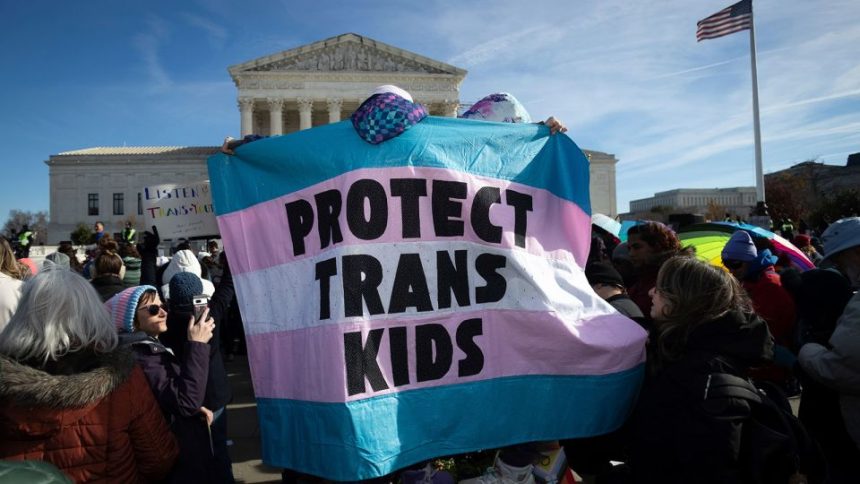The US Supreme Court will hear a case Tuesday that will determine whether a Colorado law that prohibits licensed mental health professionals from providing conversion “therapy” to minors is constitutional.
Conversion or reparative therapy promises to “convert” people from being gay, lesbian or bisexual to straight, or to change transgender and nonconforming individuals into people who identify with the sex they were labeled at birth. Research has found that the practice doesn’t work and can even be dangerous: It significantly increases a person’s risk of suicide and can cause other long-term health problems, such as depression, anxiety and high blood pressure. Children who undergo conversion therapy are more than twice as likely to run away.
At least 23 states prohibit licensed providers from offering conversion “therapy” to minors, according to the independent think tank Movement Advancement Project, and leading professional medical and mental health associations disavow it.
Despite state bans, a 2023 report found more than 1,300 conversion therapy practitioners working in 48 states and the District of Columbia. The report, from the Trevor Project, a suicide prevention organization for LGBTQ+ youth, found 600 practitioners hold active professional licenses and 700 operate in an official religious capacity. The number is likely an undercount since, the report said, because conversion therapy is “increasingly underground and conducted in secret with many practitioners not publicly advertising their services in a way that can be documented.”
A 2023 national survey found that 1 in 20 LGBTQ+ young people had been subjected to conversion therapy in the US. Nearly 200,000 people who identify as transgender have gone through some form of conversion therapy, according to a 2019 study published in the American Journal of Public Health.
Regardless of how the Supreme Court rules, the therapy may become even more common as the Trump administration pushes health care providers to offer a version of this therapy as the only kind of care for children who identify as transgender.
“The government is paving the way for a lot of harm and a lot of damage,” said Dr. Meera Shah, a family medicine physician in New York and a national board member for the professional group Physicians for Reproductive Health.
Drew, an ICU nurse in Central Valley, California, who identifies as a trans man, believes that his parents inadvertently brought him to a conversion therapist when he was 9. He asked that CNN not use his last name for his safety.
When he was old enough to pick his haircut and clothes, Drew said, he knew what his gender identity was but didn’t have the words to explain.
Choosing cowboy shirts and boots incorrectly signaled to his parents that he struggled with his gender identity.
“So they put me in therapy to fix that,” Drew said. “I don’t know if my mom understood what she was signing me up for.”
The experience still traumatizes Drew, he says, although the details of what happened in those sessions remain fuzzy. “Rather, I have traumatic flashbacks instead,” he said.
What happens in conversion therapy?
Professionals may have different methods to try to convince someone that they are not LGBTQ+. Some use traditional talk therapy, enforcing the idea that being transgender or being gay/bi is a pathology that can be “cured” and even arguing that peer pressure is to blame.
Counselors may also use behavioral modification therapy as they frame non-heterosexual or non-stereotypical gendered behavior as an “addiction” or a “compulsion.” They might encourage patients to avoid “triggers” like going to an LGBTQ+-friendly club or wearing a certain outfit and praise them for engaging in stereotypical gendered activity like wearing certain clothing or hairstyles.
They may also probe a patient’s past to determine whether an underlying issues like unprocessed trauma, abuse, mental illness or autism could have led to gender-nonconforming feelings.
There’s also a long history of documented aversion practices, including electric shock, ice baths, burning with metal coils or giving nausea-inducing drugs. Using these techniques, some may try to shame the patient about their gender or orientation, pray with them or even use exorcism as a “cure.”
When Dr. Morissa Ladinsky worked in Alabama, she said, trans patients told her that their parents put them in conversion therapy that tried to “turn the God that they loved against them.”
The approach was traumatizing, said Ladinsky, a clinical professor of pediatrics at Stanford Medicine. But there was one exception: a patient who said, “the God that I’ve grown to love would never make me this way only to turn around and marginalize me.”
Risks from conversion therapy
The process can create lasting damage and may lead to depression, anxiety, sexual problems, substance use, low self-esteem, self-blame and a lifetime of physical health problems, including high blood pressure and increased systemic inflammation, studies show.
Conversion therapy can also lead to suicide. A 2019 study found that trans people who experienced gender identity change efforts were more than twice as likely to have attempted suicide than peers who had other therapy. For children under 10, the relative risk of attempted suicide was four times as high. And trans people were 1.5 times more likely than peers who went through other therapies to experience “severe psychological distress,” the study found.
A 2020 report from the Williams Institute, a public policy research center focused on sexual orientation and gender identity at the University of California, Los Angeles School of Law, found that lesbian, gay and bisexual people who experienced conversion therapy were almost twice as likely to think about suicide and attempt suicide compared with peers who hadn’t had undergone such counseling.
“Conversion therapy – which we know isn’t actually therapy – isolates and harms kids, it scapegoats parents, and it really does divide families through blame and rejection,” said Casey Pick, director of law and policy at the Trevor Project. “No amount of pressure or talk, including conversion practices, can make a transgender person not transgender.
“This is a debunked, discredited fringe ideology.”
Ahead of the Supreme Court argument, the Trevor Project, in conjunction with American Foundation for Suicide Prevention and the National Alliance on Mental Illness, filed a friend of the court brief presenting peer-reviewed data on the serious mental health harms that conversion therapy causes LGBTQ+ youth.
Drew, the California ICU nurse, doesn’t remember much about his therapy sessions. But he does remember sobbing every Monday and Friday when his grandfather picked him up for his appointment at 2 p.m. on the dot.
Even years later, Drew said, he’d shake uncontrollably when he’d visit his parents and drive past the building where his appointments had been.
“It took me a long time to recognize why that was,” Drew said, his voice catching and pausing for deep breathing exercises to calm his nerves.
“The experience was damaging beyond my ability to explain to you,” he said. “It was damaging in ways that, 40 years later, I’m still uncovering and working through with the help of a good therapist who is practicing a kind of therapy that is actually helpful and affirmative for myself as a whole human.”
Trump administration actions
The Supreme Court case is unfolding as President Donald Trump’s administration has put a new focus on LGBTQ people.
US Health and Human Services Secretary Robert F. Kennedy Jr.
said in a letter to health systems in May that they should not rely on science-based professional guidelines for transgender children but should instead follow a highly controversial HHS review of the evidence on current care practices for pediatric gender dysphoria — a term that mental health professionals use to describe the clinically significant distress that happens when a person’s sense of gender does not match their sex assigned at birth.
The Trump administration report essentially says the only kind of care that health systems should provide children who identify as transgender are psychotherapeutic approaches including gender exploratory therapy, which discourages gender affirmation in favor of exploring the pathological roots of the young person’s trans identity. The review describes such a practice as “trying to help children and adolescents come to terms with their bodies” and equates the distress they feel related to their gender with normal “discomfort with the sexed body or with societal based expectations is common during puberty and adolescence.”
Then, at the start of Pride Month in June, the FBI encouraged whistleblowers to report health providers that offered other kinds of care.
The federal pressure on health systems worked. Among other programs, the Center for Transyouth Health and Development at Children’s Hospital Los Angeles announced in July it was shutting down. Children’s National in Washington, D.C, said in August that due to “escalating legal and regulatory risks” it would be “discontinuing the prescription of gender-affirming medications,” but would continue to offer mental health and other support services.
Research shows that exploratory therapy is far from neutral. The practice views a trans identity as maladaptive, pathological or simply wrong, experts said, and sees a cisgender identity — a gender identity that aligns with the sex assigned at birth — as normative, “healthier, preferable, and superior to a transgender or gender nonbinary identity,” according to the American Psychological Association, which is highly critical of the practice.
Gender diversity is not pathological, agrees the American Academy of Child & Adolescent Psychiatry, another organization that’s critical of the practice.
The 400+ page review that Kennedy cited, whose authors remain anonymous, says it “is not intended to serve as a clinical practice guideline and does not aim to issue treatment recommendations,” but it claims that current practices are not safe and lack a scientific basis.
Evidence about providing therapy alone is “of very low certainty,” the review says, but it lauds countries that use “exploratory” therapy alone and claims this practice is at least a “noninvasive invention” that carries “little risk” and takes a “neutral” stand that may “effectively resolve the condition noninvasively.”
“The concept of ‘noninvasive’ makes no sense here if we’re looking at mental health. What does that even really mean?” asked Florence Ashley, a Canadian law professor who wrote a book about laws banning transgender conversion practices. “If one of the things that we look at is suicidality, that’s pretty f**king invasive. You’re dead.”
Dr. Carl Streed, a clinical researcher specializing in LGBTQ+ health and an assistant professor of medicine at Boston University School of Medicine, said it’s hypocritical of the Trump administration to say there isn’t enough evidence to justify the individually tailored care typically provided to transgender youth — which is backed by dozens of medical organizations and may include therapy, social and legal help, and for older patients, hormones or surgery — while acknowledging that therapy alone is “of very low certainty.”
“The report really provides no other alternative other than conversion therapy, and because it is from the HHS, it is essentially going to be a ‘legitimizing report.’ And it’s going to be used to eventually change policies around the provision of care,” Streed added.
HHS says in the report that exploratory therapy is not conversion therapy. But because the aim of the practice is to “resolve” the issue of gender rather than resolve the distress the person feels about their gender, experts say it is conversion therapy by a different name.
“Honestly, whenever anybody says ‘gender exploratory therapy,’ they really are talking about conversion therapy,” Streed said. “They’re not talking about anything that acknowledges people’s full spectrum of gender.”
In California, Drew said that while he’s still working through the trauma he experienced in conversion therapy, it hasn’t held him back from having a successful career, a happy marriage and kids. And even though it’s difficult to talk about, he wants parents to know about his experience.
“I don’t want anybody else to go through what I went through, and if another parent out there can hear that conversion therapy will be harmful to their child and consider a different way to move forward, that Is worth any discomfort or pain that I have now talking about it,” Drew said.
Despite the trauma, he bears no ill will toward his childhood therapist.
“My parents eventually saw me for who I am, and they accepted me and loved me and had been extremely supportive of me,” Drew said. “So I’d like to give that therapist the grace that perhaps they could have learned and grown as a therapist and understood the harm that they were causing and learn to do better by trans youth.”
For more CNN news and newsletters create an account at CNN.com









